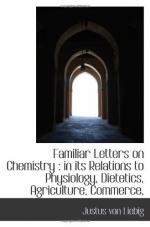The cause of this premature decay is now obvious. The perfectly-developed leaves absorb continually carbonic acid and ammonia from the atmosphere, which are converted into elements of new leaves, buds, and shoots; but this metamorphosis cannot be effected without the aid of the alkalies, and other mineral substances. If the soil is moist, the latter are continually supplied to an adequate amount, and the plant retains its lively green colour; but if this supply ceases from a want of moisture to dissolve the mineral elements, a separation takes place in the plant itself. The mineral constituents of the juice are withdrawn from the leaves already formed, and are used for the formation of the young shoots; and as soon as the seeds are developed, the vitality of the leaves completely ceases. These withered leaves contain only minute traces of soluble salts, while the buds and shoots are very rich in them.
On the other hand, it has been observed, that where a soil is too highly impregnated with soluble saline materials, these are separated upon the surface of the leaves. This happens to culinary vegetables especially, whose leaves become covered with a white crust. In consequence of these exudations the plant sickens, its organic activity decreases, its growth is disturbed; and if this state continues long, the plant dies. This is most frequently seen in foliaceous plants, the large surfaces of which evaporate considerable quantities of water. Carrots, pumpkins, peas, &c., are frequently thus diseased, when, after dry weather, the plant being near its full growth, the soil is moistened by short showers, followed again by dry weather. The rapid evaporation carries off the water absorbed by the root, and this leaves the salts in the plant in a far greater quantity than it can assimilate. These salts effloresce upon the surface of the leaves, and if they are herbaceous and juicy, produce an effect upon them as if they had been watered with a solution containing a greater quantity of salts than their organism can bear.
Of two plants of the same species, this disease befalls that which is nearest its perfection; if one should have been planted later, or be more backward in its development, the same external cause which destroys the one will contribute to the growth of the other.
LETTER XII
My dear Sir,
Having now occupied several letters with the attempt to unravel, by means of chemistry, some of the most curious functions of the animal body, and, as I hope, made clear to you the distinctions between the two kinds of constituent elements in food, and the purposes they severally subserve in sustaining life, let me now direct your attention to a scarcely less interesting and equally important subject—the means of obtaining from a given surface of the earth the largest amount of produce adapted to the food of man and animals.
Agriculture is both a science and an art. The knowledge of all the conditions of the life of vegetables, the origin of their elements, and the sources of their nourishment, forms its scientific basis.




